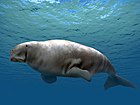| Kutchisiren Temporal range: Miocene, | |
|---|---|
 | |
| Scientific classification | |
| Domain: | Eukaryota |
| Kingdom: | Animalia |
| Phylum: | Chordata |
| Class: | Mammalia |
| Order: | Sirenia |
| Family: | Dugongidae |
| Subfamily: | Dugonginae |
| Genus: | † Kutchisiren Bajpai et al., 2010 |
| Species | |
| |
Kutchisiren is an extinct genus of mammal which existed in what is now India in Khari Nadi Formation during the Miocene period. [1] It was named by S. Bajpai, D. P. Domning, D. P. Das, J. Velez-Juarbe, and V. P. Mishra in 2010, and the type species is Kutchisiren cylindrica. It was originally named Kotadasiren gracilis (as a nomen nudum) in 1994, by Das and Basu. [1]
